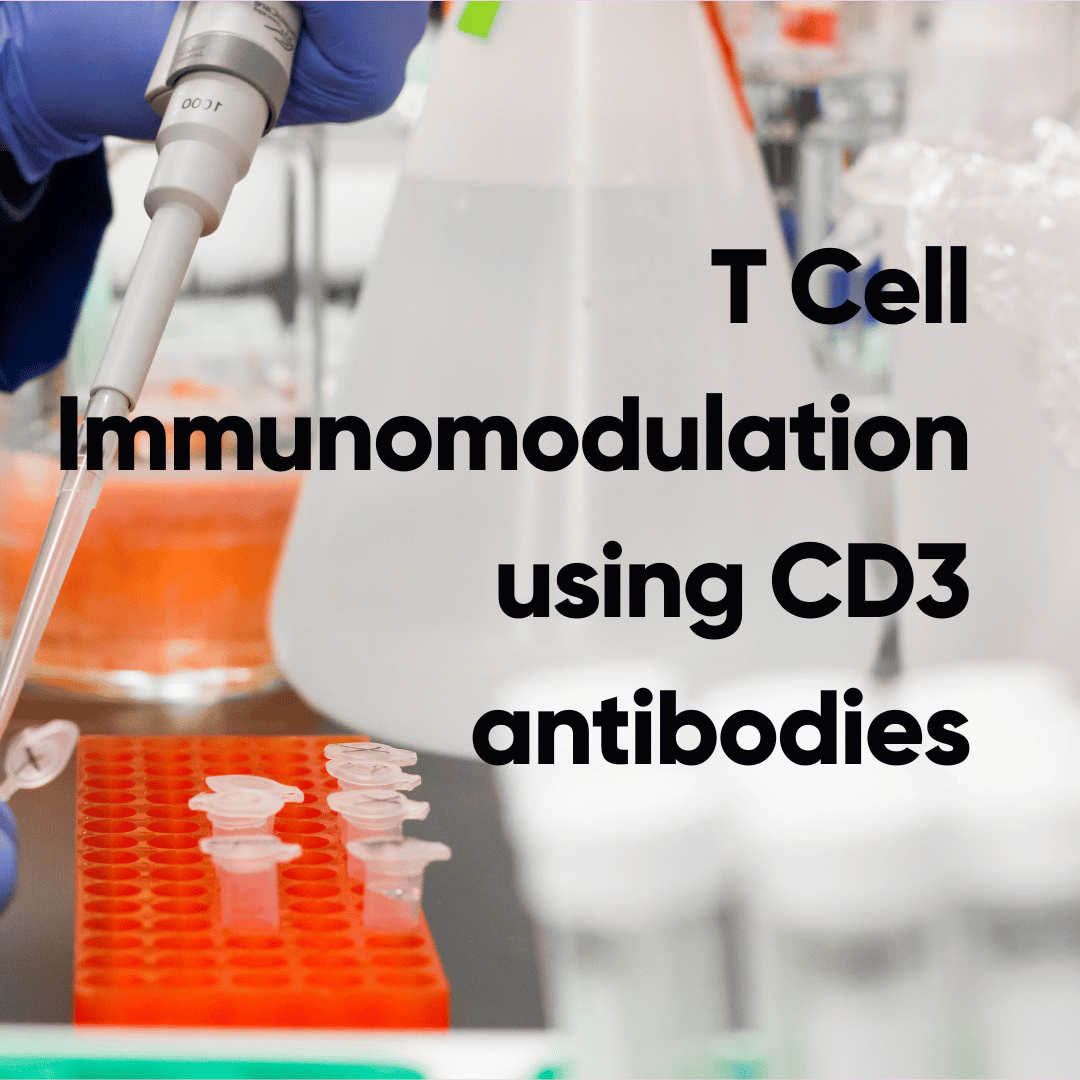In vivo effects of T cell immunomodulation using anti-CD3 antibodies

In vivo effects of T cell immunomodulation using anti-CD3 antibodies
T cell-mediated immune responses play a crucial role in adaptive immunity, autoimmune diseases, and transplant rejection. Modulation of T cell activity has thus become a primary focus in immunotherapy research. Anti-CD3 antibodies, which target the CD3 complex on T cells, have emerged as potent immunomodulatory agents with diverse in vivo effects. This article examines the current understanding of anti-CD3 antibody-mediated T cell immunomodulation in vivo and its therapeutic implications.
Mechanism of Action
Anti-CD3 antibodies primarily act by binding to the ε chain of the CD3 complex, a critical component of the T cell receptor (TCR) signaling machinery. In vivo administration of anti-CD3 antibodies induces a cascade of events that ultimately leads to T cell modulation:
1. Initial T cell activation
Paradoxically, the initial binding of anti-CD3 antibodies triggers a transient activation of T cells, characterized by cytokine release and proliferation.
2. Activation-induced cell death (AICD)
Following the initial activation, a substantial proportion of T cells undergo apoptosis through AICD, particularly affecting previously activated or memory T cells.
3. Induction of anergy
Surviving T cells often enter a state of anergy, characterized by impaired responsiveness to subsequent TCR stimulation.
4. Regulatory T cell (Treg) expansion
Anti-CD3 treatment has been shown to preferentially expand and enhance the suppressive function of Foxp3+ Tregs, contributing to long-term immunomodulation.
In Vivo Effects
The in vivo effects of anti-CD3 antibodies are multifaceted and depend on factors such as antibody dose, isotype, and timing of administration:
1. T cell depletion:
High doses of anti-CD3 antibodies can lead to significant T cell depletion in peripheral blood and lymphoid tissues. This effect is particularly pronounced with Fc receptor-binding antibodies, which can induce antibody-dependent cell-mediated cytotoxicity (ADCC) and complement-dependent cytotoxicity (CDC).
2. Cytokine release syndrome:
The initial T cell activation phase can result in a rapid and substantial release of pro-inflammatory cytokines, including TNF-α, IFN-γ, and IL-6. This cytokine storm can lead to severe side effects, necessitating careful dosing strategies in clinical applications.
3. Altered T cell trafficking:
Anti-CD3 treatment modifies the expression of adhesion molecules and chemokine receptors on T cells, affecting their migration patterns and tissue distribution.
4. Immunological synapse modulation:
In vivo imaging studies have revealed that anti-CD3 antibodies can disrupt the formation and stability of immunological synapses between T cells and antigen-presenting cells, potentially contributing to long-term immunomodulation.
5. Bystander suppression:
The induction of regulatory T cells and the modulation of the cytokine milieu can lead to bystander suppression, where the immunomodulatory effects extend beyond the directly targeted T cells.
Therapeutic Applications
The diverse in vivo effects of anti-CD3 antibodies have been harnessed for various therapeutic applications:
Transplantation: Anti-CD3 therapy has shown efficacy in preventing and treating allograft rejection in solid organ and hematopoietic stem cell transplantation.
Autoimmune diseases: Clinical trials have demonstrated promising results in treating type 1 diabetes, multiple sclerosis, and inflammatory bowel disease using anti-CD3 antibodies.
Cancer immunotherapy: Modified anti-CD3 antibodies, such as bispecific T cell engagers (BiTEs), have shown potential in redirecting T cells against tumor cells.
Common Anti-CD3 Antibody Clones Used In Vivo
Several anti-CD3 antibody clones have been developed and used in vivo for research and clinical applications. These clones vary in their specificity, affinity, and Fc receptor binding properties, which can influence their in vivo effects:
OKT3 (Muromonab-CD3):
Origin: Mouse IgG2a
Characteristics: The first anti-CD3 monoclonal antibody approved for clinical use
Applications: Prevention of acute rejection in organ transplantation
Notable features: High immunogenicity due to its murine origin, potent T cell activation, and cytokine release syndrome
Visilizumab (HuM291):
Origin: Humanized IgG2
Characteristics: Binds to the CD3ε chain with high affinity
Applications: Investigated for treatment of ulcerative colitis and graft-versus-host disease
Notable features: Lower cytokine release compared to OKT3, but still associated with significant side effects
Teplizumab:
Origin: Humanized IgG1
Characteristics: FcR non-binding antibody
Applications: Studied extensively in type 1 diabetes prevention and treatment
Notable features: Reduced cytokine release and T cell depletion compared to FcR-binding antibodies
Otelixizumab:
Origin: Humanized IgG1
Characteristics: Aglycosylated antibody with reduced FcR binding
Applications: Investigated for type 1 diabetes and rheumatoid arthritis
Notable features: Lower risk of cytokine release syndrome, while maintaining immunomodulatory effects
SP34:
Origin: Mouse IgG3
Characteristics: Commonly used in non-human primate studies
Applications: Preclinical research in transplantation and autoimmune diseases
Notable features: Cross-reactive with human and non-human primate CD3
145-2C11:
Origin: Hamster IgG
Characteristics: Specific for mouse CD3ε
Applications: Widely used in mouse models of autoimmune diseases and transplantation
Notable features: Potent T cell activator in mice, often used to induce experimental autoimmune conditions
KT3:
Origin: Rat IgG2a
Characteristics: Binds to mouse CD3
Applications: Used in mouse models for in vivo T cell depletion and immunosuppression
Notable features: Effective for short-term T cell depletion in mice
These anti-CD3 antibody clones represent a diverse toolkit for in vivo T cell immunomodulation. The choice of clone depends on the specific research question, target species, and desired immunomodulatory effect. Humanized and FcR non-binding antibodies have gained prominence in clinical applications due to their reduced side effect profiles, while murine antibodies remain valuable tools in preclinical research.
The development of these various clones highlights the ongoing efforts to optimize the therapeutic potential of anti-CD3 antibodies while minimizing adverse effects. As research progresses, novel engineered variants of these antibodies are likely to emerge, further expanding the repertoire of tools available for T cell immunomodulation in vivo.
Conclusion
The in vivo effects of T cell immunomodulation using anti-CD3 antibodies are complex and multifaceted. While challenges remain, particularly in managing side effects and optimizing dosing regimens, the unique ability of anti-CD3 antibodies to induce long-term immunomodulation through multiple mechanisms continues to drive research and clinical applications. As our understanding of the in vivo effects deepens, novel anti-CD3 therapies with improved efficacy and safety profiles are likely to emerge, potentially revolutionizing the treatment of immune-mediated disorders.

